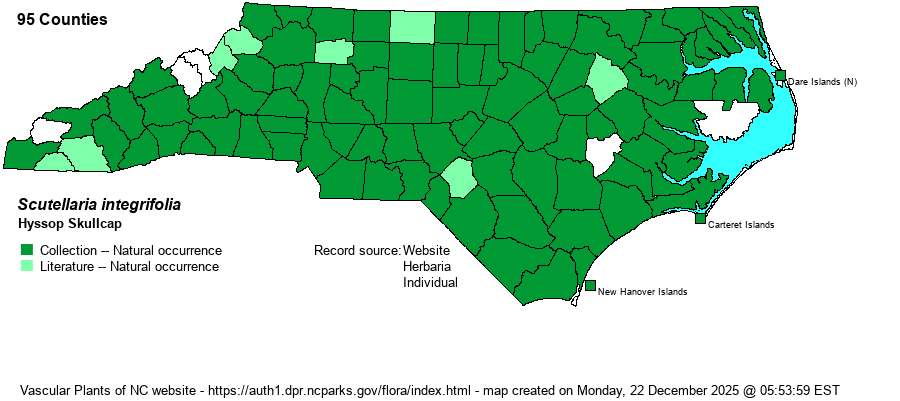| Author | L. | |
| Distribution | Occurs statewide and presumably is found in all 100 counties, though of spotty occurrence in the Mountains.
This is a Southeastern species, ranging north to MA and ranging southwestward only north to OK, and then south to southern FL and eastern TX.
| |
| Abundance | Common and widespread across the Piedmont and nearly all of the Coastal Plain; only just fairly common in the southern Mountains, but scarce to rare in the northern Mountains. | |
| Habitat | This species has a wide range of mostly open to partly shaded habitats, in many moisture situations. In the Coastal Plain, this is essentially a wetland species, growing around pond margins, seepages, savanna edges, bottomland openings, and other damp ground. However, in the Piedmont it is often found along mesic wooded margins, powerline clearings, stream banks, and many other places, often fairly dry. In the mountains it prefers damp ground of wet meadows, stream margins, and other such sites, but it certainly grows in upland wooded margins and other drier openings. |
| Phenology | Blooms from May into July, and fruits from July to August. | |
| Identification | This is the most common Scutellaria in most parts of the state, seen on many walks. It is a farily small skullcap, with a mainly unbranched stem reaching about 1.5 feet tall at most, with numerous pairs of narrowly elliptic leaves. Each leaf is only about 1.5 inches long but only about 2/5-inch wide, mostly entire, with upper leaves becoming smaller. The flowers are mostly in the upper leaf axils and stem tip, with many leafy bracts (i.e., flowers are not naked at the top of the plant); each flower is lavender-blue and about 3/4-inch long, with the typically hooded upper lip of the genus. Other species in the genus have larger leaves that are more serrated or wider, or both. It often grows with S. elliptica, but that species has much wider leaves that are ovate and obviously scalloped on the margin. This is not a particularly showy skullcap when in bloom, though it does catch your attention, in part as it might be one of just a few lavender-blue flowering plants seen on many walks along wooded borders and other places in late spring and early summer. | |
| Taxonomic Comments | None
| |
| Other Common Name(s) | Narrowleaf Skullcap, Helmet Skullcap, Helmet-flower, Hyssopleaf Skullcap | |
| State Rank | S5 | |
| Global Rank | G5 | |
| State Status | | |
| US Status | | |
| USACE-agcp | FAC link |
| USACE-emp | FACW link |

